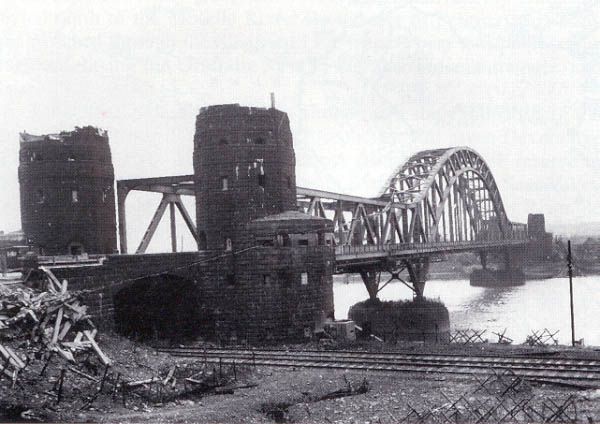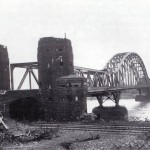Last month we told you about Marion County, WV 6th grader Josh Baroni and his social studies project about the bridge at Remagen during WWII. Yesterday, he won first place at the Marion County Social Studies fair and will be going to the regional competition in March. Congratulations Josh!
Since his initial entry in the social studies fair, he’s done a lot more research and work and we thought we’d post his updated report. He’s done a great job so far and we’re really looking forward to hearing how he does at the next competition.
Remagen and its Bridge
By Josh Baroni
The Remagen Bridge was the beginning of the end of WWII. Crossing the Bridge made it easier than going into the water. For many weeks the U.S. had been trying to figure out how to cross the Rhine. Every time the U.S. got near a bridge that would cross the Rhine the Germans would blow it up.
Many generals like Montgomery and Patch each had their own way to cross the Rhine. General Eisenhower first agreed with General Patch’s plan but over time General Eisenhower grew to like General Montgomery’s plan which he called operation Market Garden. He said that operation Market Garden would end the war by Christmas. But Montgomery’s plan failed miserably when the final bridge across the Rhine could not be secured. Many other Generals proposed new plans but each one of their plans fail miserably either when the bridge is blown or they are forced to retreat.
One day the U.S. III corps spied the small town of Remagen at the base of Victoria Mountains. Just beyond Remagen was an old railroad bridge that crossed the Rhine. When soldiers saw this they leaped into the air for joy. The Ludendorff Bridge was the last bridge that led across the Rhine was intact for wounded German soldiers to retreat across the Rhine. Since the Germans waited for their soldiers to retreat across the bridge they decided to wait for the U.S. to actually come onto the bridge before blowing it up that way they could kill some Americans that way they would get the last laugh. But after the bridge was ‘blown’ it was still standing!
The members of the 9th armored division were the first to cross it, because they had good training. The Germans tried to detonate the Bridge by setting up explosives on the bridge. Luckily two polish engineers cut most of the wires so their Brave act saved many American lives. Although a few bombs exploded it actually lifted the bridge up then settled back down. As the Germans saw that their plan had failed they lined up a bunch of men, tanks, and airplanes (to try to blow up the bridge) as the last line of defense. As machine guns and soldiers fired at the Americans the Americans were dodging every attack the Germans launched at them. Although the Americans suffered heavy casualties they kept fighting and fighting until the Germans couldn’t hold on any longer. As they retreated Americans swarmed over the Bridge. For some, their brilliant effort earned them Distinguished Service Cross.
The Rhine is crossed by the U.S.! Jaws dropped open in the world as far as U.S. to Great Britain. Many could not believe that the U.S. crossed the bridge. Many started to call it “Miracle at Remagen.†After U.S. capture they started to repair the bridge but despite the Americans best effort the bridge collapsed into the Rhine killing twenty-eight U.S. soldiers. No one knows how it happened.
You’re probably asking what did they eat or sleep during this battle. According to Ken Hechler the U.S. Army historian assigned to this battle, they’re food wasn’t very good because all they had was a big lump of cheese or beef soup. Since they had no bed they often slept on the ground but sometimes went into a house to sleep.
The weather was like West Virginia in March. The nights were cold but the days were sunny. There was no rain or snow on the day of the capture.
Conclusion
The capture of the bridge led tanks and men straight into Germany thus shortening the war. So as General Eisenhower says it “the bridge was worth its weight in gold.â€
My Interest in this Bridge
I was interested with the bridge for several reasons. I noticed that this bridge was referred to in my WWII video games and several of my WWII movies. I wanted to find out if this bridge was important and why.
My Interview with Ken Hechler
Why was this bridge important?
It led to the end of the war. The men felt it was much easier to cross the river using the bridge because it kept their feet dry and their equipment dry. It demonstrated two things – members of the 9th Armor Division had good training and initiative to take advantage of the fact the bridge was still standing.
What happened at the bridge leading up to the capture?
The Germans tried to explode the bridge but couldn’t. The German charges were not very good as was during the beginning of the war. The Swedish disconnected most of the charges. When the Germans exploded the bridge it actually lifted up from its foundation then settled back down. The Germans up in the gun towers shot at the allies as they tried to cross.
What was your job during the war?
I was a Captain. I was drafted as a private in 1942. After a while I tried out for officer candidate school. By the end of the war I reached Major. I used a M1 that had 12 rounds until I had to reload. I also carried a pistol that wasn’t really effective. I was not injured in the war. In fact I was about ten miles away from where it happened. After my duty I gave advice to Truman even though Truman was a smart man. He just told me what he needed. Truman knew his objects very well so he didn’t really need my help.
Final Comment from Ken Hechler
“Anytime you’re in a war – in a war you’re scared.†said Ken Hechler.†But artillery is the scariest because first it shoots to the left of you then the right by then you want to get in a ditch because the next shot was coming right at you.â€
Map of the rural district Landkreis Ahrweiler, Rhineland-Palatinate with the town of Remagen
http://en.wikipedia.org/wiki/File:Gem_kr_remagen.png
1945 -Â This U.S. soldier waits for an arial strike to weaken the germans before crossing the Remagen bridge.
http://gadabyte.com/ww-ii/images/europe/infantry/remagen3.jpg
The maps of remagen and other cities looked like this map shown here.
http://wwww.battlegroundtools.com/maps/venlo.jpg
Montgomery’s plan Market Garden (shown here) failed when the final bridge couldn’t be captured.
http://www.monografias.com/trabajos41/operation-market/Image1234.gif
Devers, Patton,Patch, and Bradley each had their own plan to cross the Rhine.
http://www.onwar.com/maps/wwii/westfront/xrhineus.htm
The map shown here shows what the Bridge was like when they looked at the map.
http://www.onwar.com/maps/wwii/westfront/ludendorffbrdg45.htm
Bibliography
Hechler, Ken. Statesman and Historian. Personal Interview.  October 21, 2009.
Hechler, Ken. The Bridge at Remagen. Presidio Press, July 26, 2005.
Robinson, Warren A. “Battle at the Remagen Bridge and Bridgehead.†WWII stories. New Jersey Public Television & Radio.
www.njn.net/television/special/war/stories/robinson/battle.html
Hickman, Kennedy. “The Bridge at Remagen.†Military History. About.com.
http://militaryhistory.about.com/od/worldwarii/p/remagen.htm
“Remagen and its bridge.†Remagen. Wikipedia. Updated November 16, 2009. http://en.wikipedia.org/wiki/Remagen
“Operation Market Garden.†Map. Monografias.com. March 7, 1945.
http://www.monografias.com/trabajos41/operation-market/Image1234.gif
“Infantry at Remagen.†Photo. Gadabyte.com.
http://gadabyte.com/ww-ii/images/europe/infantry/remagen3.jpg
“Arial Map of Remagen.†Photo. Venlo.
http://wwww.battlegroundtools.com/maps/venlo.jpg
“Rhine Crossing at Remagen.†Map. OnWar.com. March 7, 1945.
http://www.onwar.com/maps/wwii/westfront/remagen45.htm
“American Army Rhine Crossings.†Map. OnWar.com. March 11-28, 1945.
http://www.onwar.com/maps/wwii/westfront/xrhineus.htm
“Ludendorff Bridge at Remagen.†Map. OnWar.com. March 7, 1945.
http://www.onwar.com/maps/wwii/westfront/ludendorffbrdg45.htm
“Call of Duty Finest Hour.†Game. Activision. November 16, 2004.


Leave a Reply